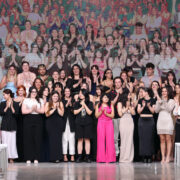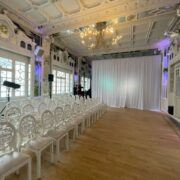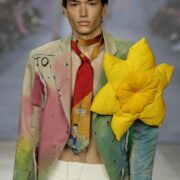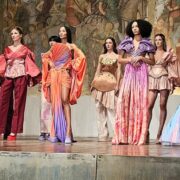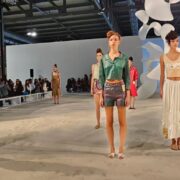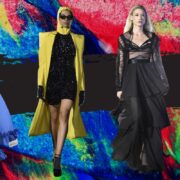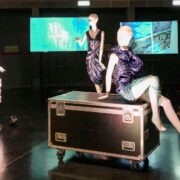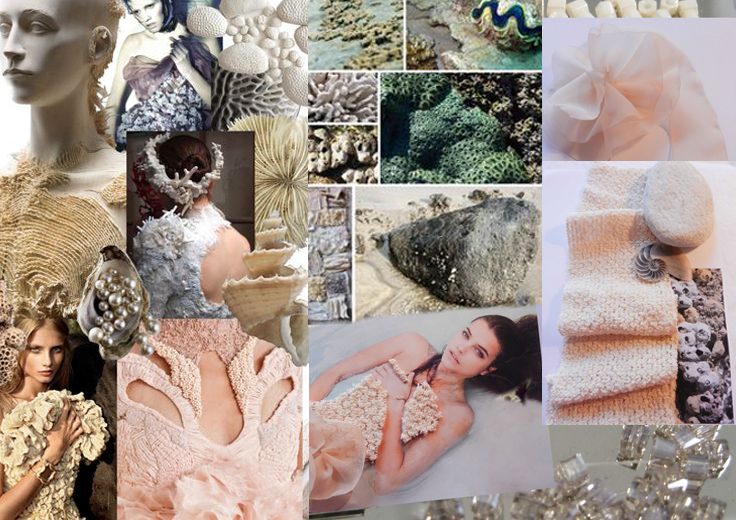
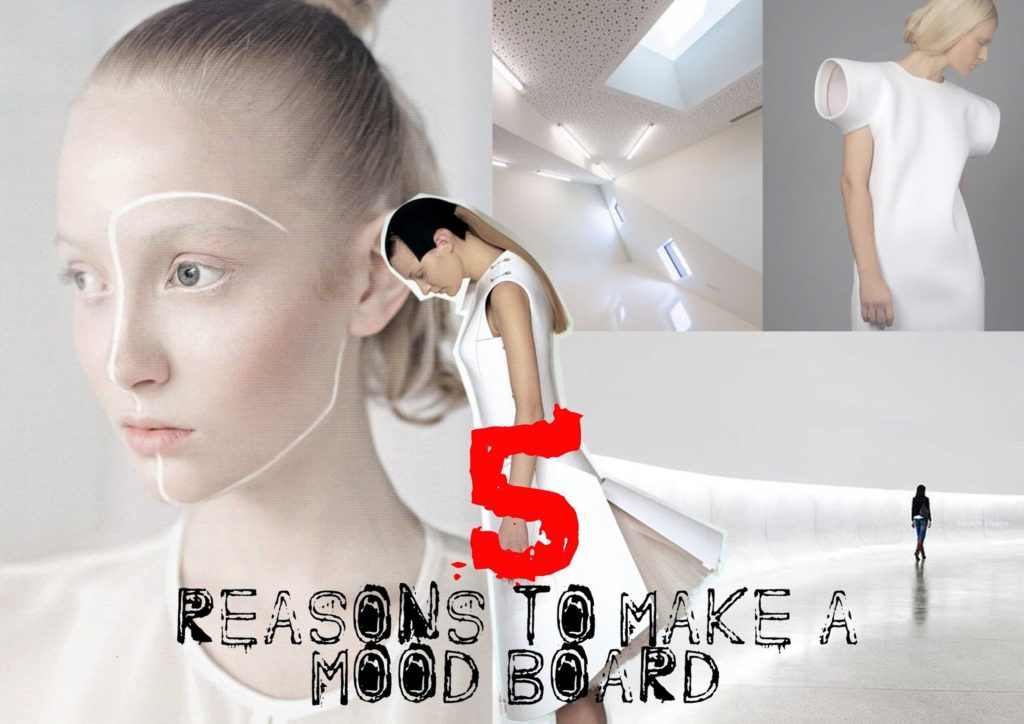
Il modo più semplice per dare una risposta a queste domande è parlare di uno degli strumenti fondamentali dei progettisti di tutto il mondo:
mood board ispirazionale<
Viene anche chiamato in altri modi, ma che fondamentalmente hanno tutti lo stesso significato. Per iniziare a prendere familiarità con le terminologie tecniche, essi sono: concept board, tableau d’ispirazione, tendence mood board…
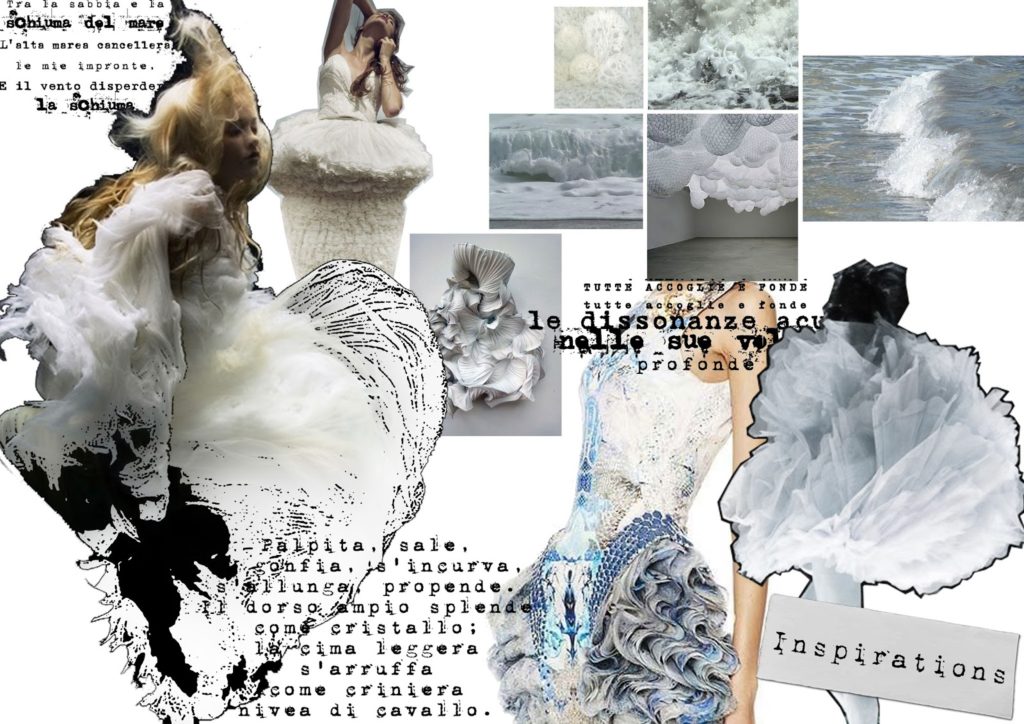
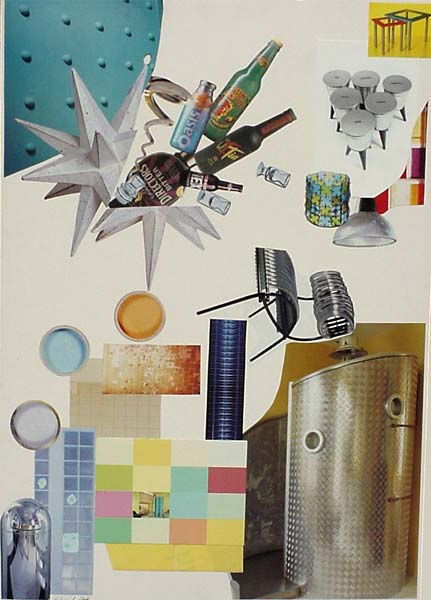
E’ una forma di materiale visivo che serve a creare degli stimoli, a solleticare la nostra fantasia. Solitamente è formato da una o più tavole contenenti immagini ritagliate da riviste (nel caso di un tableau cartaceo) o da composizioni di foto digitali (scaricate da internet o tratte da libri e fashion magazines), che servono a rappresentare un concetto, un’atmosfera.
Ma il mood board può anche contenere oggetti, disegni e tessuti, proponendo in tal modo non solo il tema di ispirazione, ma anche i materiali, le finiture e i colori che saranno utilizzati nella realizzazione del progetto di collezione.
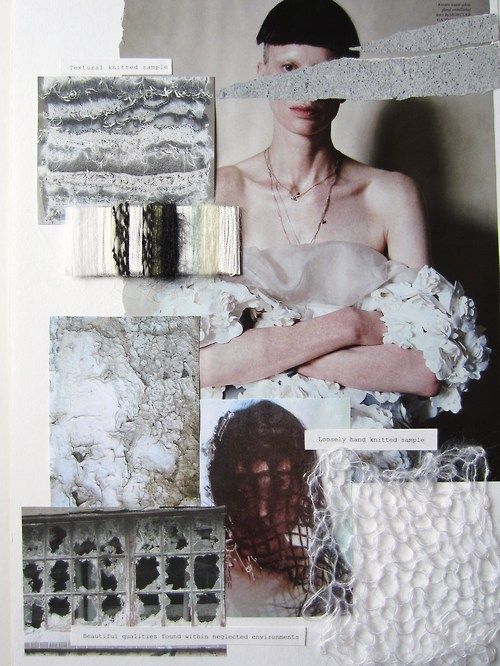
1) SEPARA IL CONCETTO (IDEA) DAL PROGETTO FINALE
Il mood, attraverso l’assemblaggio (in forma di collage) di immagini e materiali diversi, focalizza l’attenzione sul concetto iniziale o ispirazione che è alla base del progetto, rimandando a poi le considerazioni sui particolari della collezione, che potrebbero altrimenti fuorviare il designer.
Il mood, attraverso l’assemblaggio (in forma di collage) di immagini e materiali diversi, focalizza l’attenzione sul concetto iniziale o ispirazione che è alla base del progetto, rimandando a poi le considerazioni sui particolari della collezione, che potrebbero altrimenti fuorviare il designer.
2) AIUTA A CREARE CONSENSI E A FARSI “CAPIRE” QUANDO SI LAVORA IN GRUPPO
3) COINVOLGE PIU’ PERSONE NEL PROCESSO DI DESIGN
Sia nel proprio team stilistico, sia nel mostrare il proprio lavoro ad un cliente o ad un responsabile, è molto difficile riuscire a far capire alle altre persone come è nata l’ispirazione e come da essa vogliamo partire per sviluppare la nostra collezione.
Dato che il mood board non contiene dettagli del disegno finale che possano distrarre l’attenzione, è sicuramente più facile, utilizzando questa tecnica, spiegare le basi fondamentali della collezione e a creare consensi sul concetto iniziale, in modo da poter discutere i dettagli successivamente.
Dato che creare un mood board può richiedere competenze tecniche e grafiche particolari (come ad esempio un buon uso dei software grafici), difficilmente qualcun’altro può intervenire in questo particolare momento creativo oltre a colui che è preposto a realizzarlo, ovvero il designer stesso.
Spiegarsi attraverso il mood board aiuta lo stilista a far capire ai propri collaboratori in modo inequivocabile il concept e a farli partecipare attivamente e in maniera costruttiva durante tutta la fase di progettazione della collezione.
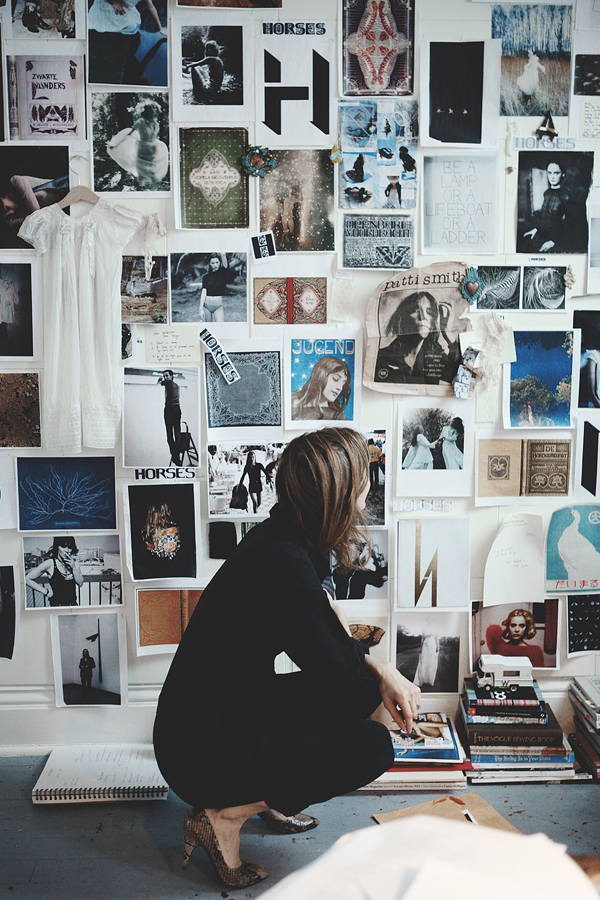
I designer cadono spesso nella trappola di ricercare la perfezione, ma le tempistiche legate alla stesura di una intera collezione (spesso composta da centinaia di capi e outfits) lasciano giusto il tempo di buttare giù più idee possibili.
Senza un tableau d’ispirazione che funga da guida, il rischio di perdersi lungo la via e di realizzare in tal modo una collezione/non collezione, ovvero un insieme disordinato di abiti (e non coordinato come dovrebbe essere), è molto alto. Il mood board libera il designer durante la fase iniziale di realizzazione delle bozze e degli schizzi preparatori, aiutandolo a seguire il concetto iniziale rapidamente e facilmente. 5) EVITA ERRORI
Il mood board mostra chiaramente l’idea del designer e diventa un punto di riferimento nella fase successiva del lavoro e i disegni definitivi rispecchiano il concetto del mood, la collezione sarà composta da un insieme ben coordinato di capi, da colori definiti e calibrati, dai tessuti più adatti alla realizzazione finale degli abiti e da dettagli curati che renderanno i modelli unici e particolari.
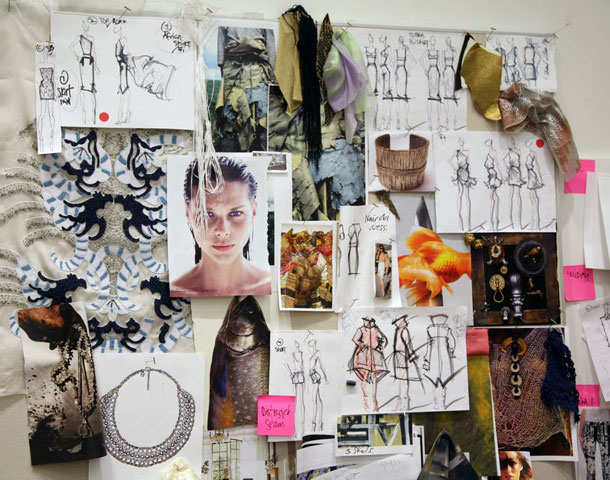
In what way a fashion designer can express his inspiration? How can be make it clear to own design team which creative vision that may give rise to a fashion collection?
The easiest way to answer these questions is to talk about a key instrument of designers of all over the world: inspirational mood board.
It’s also called in other ways, but that basically have all the same meaning. To begin becoming familiar with technical terms, they are: concept board, inspiring tableau, tendence mood board…
The mood board is one of the basic elements used in the research of inspiration and give order to own ideas. For this reason it’s used not only by the fashion designers, but also by designers of fabrics, interior decorators and industrial designers.
All that is collection (whether we are talking of clothing, furniture, accessories or cars) it can be represented in the primitive stage of conceiving a concept from mood boards.
The easiest way to answer these questions is to talk about a key instrument of designers of all over the world: inspirational mood board.
It’s also called in other ways, but that basically have all the same meaning. To begin becoming familiar with technical terms, they are: concept board, inspiring tableau, tendence mood board…
The mood board is one of the basic elements used in the research of inspiration and give order to own ideas. For this reason it’s used not only by the fashion designers, but also by designers of fabrics, interior decorators and industrial designers.
All that is collection (whether we are talking of clothing, furniture, accessories or cars) it can be represented in the primitive stage of conceiving a concept from mood boards.
What is a mood board?
A form of visual material that is used to create stimulus, to tickle our fancy. Usually it consists of one or more tables containing pictures cut from magazines (in the case of a paper tableau) or digital photo compositions (downloaded from internet or from books and fashion magazines), which are used to represent a concept, an atmosphere.
But the moodboards may also contain objects, sketches and fabrics, thus offering not only the theme of inspiration, but also the materials, finishes and colors that will be used in the project of collection.
A form of visual material that is used to create stimulus, to tickle our fancy. Usually it consists of one or more tables containing pictures cut from magazines (in the case of a paper tableau) or digital photo compositions (downloaded from internet or from books and fashion magazines), which are used to represent a concept, an atmosphere.
But the moodboards may also contain objects, sketches and fabrics, thus offering not only the theme of inspiration, but also the materials, finishes and colors that will be used in the project of collection.
Here 5 good reasons to use mood boards
When a fashion designer began to design his own collection has to express his inspiration, which is the concept behind the “story“ he wants to tell through the realization of clothes and accessories.
The initial idea is manifested in the collecting of inspirational images and color, details that give rise to a thousand ideas, in infinite possibilities of combinations. But the planning of a collection requires method, and all this creative emphasis, this surplus of suggestions, can divert the designers from project routes, that instead should always be well clear.
Here then 5 good reasons to draft a concept mood boards:
When a fashion designer began to design his own collection has to express his inspiration, which is the concept behind the “story“ he wants to tell through the realization of clothes and accessories.
The initial idea is manifested in the collecting of inspirational images and color, details that give rise to a thousand ideas, in infinite possibilities of combinations. But the planning of a collection requires method, and all this creative emphasis, this surplus of suggestions, can divert the designers from project routes, that instead should always be well clear.
Here then 5 good reasons to draft a concept mood boards:
1) SEPARATE THE CONCEPT (IDEA) FROM THE FINAL PROJECT
The mood, through the assembly (in the form of collage) of images and materials, focuses attention on the original concept or inspiration that is behind the project, referring later the considerations on the details of the collection, which could otherwise mislead the designer
The mood, through the assembly (in the form of collage) of images and materials, focuses attention on the original concept or inspiration that is behind the project, referring later the considerations on the details of the collection, which could otherwise mislead the designer
2) HELPS TO CREATE CONSENSUS AND TO BECOME “UNDERSTAND” WHEN WORKING IN A GROUP
Both in his design team, or showing his work to a client or to a responsible, it’s very difficult to make clear to other people how inspiration has born and in which way we want to start to develop our collection from it.
Because the mood board doesn’t contain details of the final sketch that might distract, is certainly easier, using this technique, explain the fundamentals of the collection and create consensus on the original concept, in order to discuss the details later.
Both in his design team, or showing his work to a client or to a responsible, it’s very difficult to make clear to other people how inspiration has born and in which way we want to start to develop our collection from it.
Because the mood board doesn’t contain details of the final sketch that might distract, is certainly easier, using this technique, explain the fundamentals of the collection and create consensus on the original concept, in order to discuss the details later.
3) INVOLVES MORE PEOPLE IN THE DESIGN PROCESS
Because creating a moodboard may require specific technical and graphic knowledge (such as a good use of graphics software), hardly anyone else may intervene in this particular moment of creation as well as the one who is responsible to realize it, that is the designer himself.
Explain through mood board helps the designer to make clear to his staff in an unequivocal way the concept, and make them actively and constructively participate throughout the design phase of the collection.
Because creating a moodboard may require specific technical and graphic knowledge (such as a good use of graphics software), hardly anyone else may intervene in this particular moment of creation as well as the one who is responsible to realize it, that is the designer himself.
Explain through mood board helps the designer to make clear to his staff in an unequivocal way the concept, and make them actively and constructively participate throughout the design phase of the collection.
4) SPEED UP THE DRAWING PHASE
Designers often fall into the trap of seeking perfection, but the timing related to the drafting of a whole collection (often consisting of hundreds of garments and outfits) leave just enough time to jot down more ideas as possible.
Without a tableau of inspiration that acts as guide, the risk of getting lost along the way and thereby realize a collection/non-collection, a messy set of clothes (and not coordinated as it should be), is very high; the mood board let free fashion designers during the initial phase of implementation of the drafts and sketches, helping him to follow the initial concept quickly and easily.
Designers often fall into the trap of seeking perfection, but the timing related to the drafting of a whole collection (often consisting of hundreds of garments and outfits) leave just enough time to jot down more ideas as possible.
Without a tableau of inspiration that acts as guide, the risk of getting lost along the way and thereby realize a collection/non-collection, a messy set of clothes (and not coordinated as it should be), is very high; the mood board let free fashion designers during the initial phase of implementation of the drafts and sketches, helping him to follow the initial concept quickly and easily.
